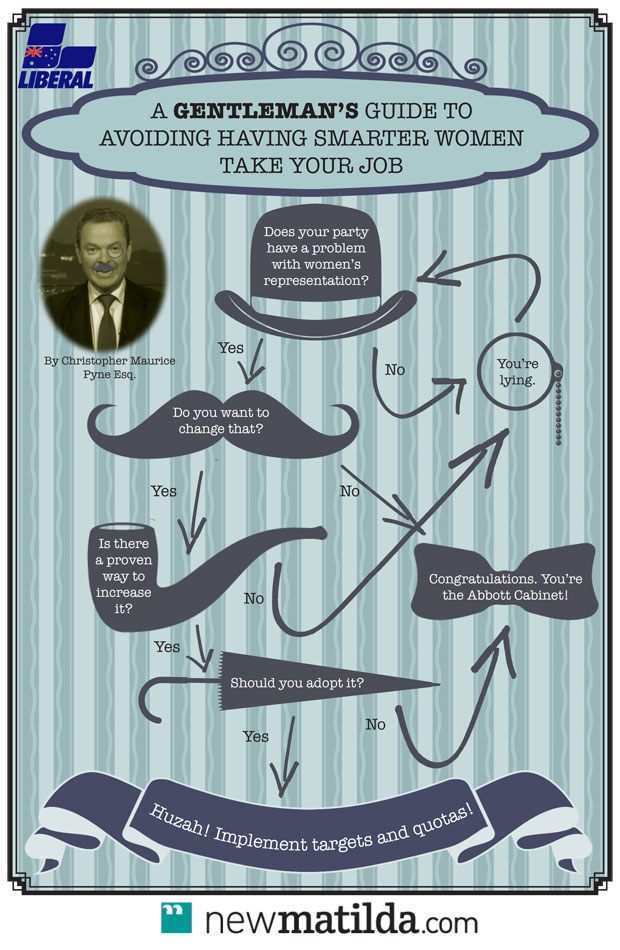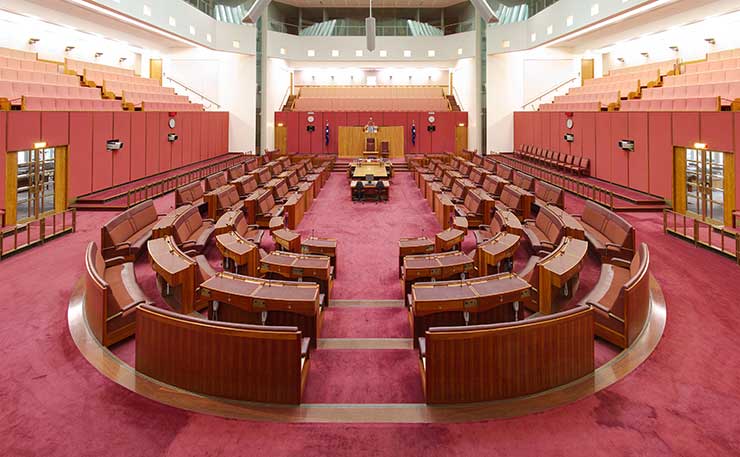In Australia, at the federal level, the proportion of women in the House of Representatives is 26.7 per cent. In the Senate it is 38.2 per cent. This places Australia in 44th position according to the Inter-Parliamentary Union.
In 2014, a NSW Greens MP, Mehreen Faruqi wrote in New Matilda about this increasing democratic deficit. Faruqi said that the Greens have ‘strong gender equality focus in their constitution, party structures and pre-selection processes’ and she challenged her parliamentary colleagues to take action.
Both major parties are talking about the need for more women in parliament. The Australian Labor Party has committed itself to introduce quotas to ensure equal representation among Labor politicians across parliaments.
The Liberal Party is considering the development of ‘frameworks’ to ensure more women join the party and become candidates because ‘gender does matter’ ‘to enhance the party’s long term electoral prospects.’
The Prime Minister recently endorsed a Menzies Research Centre discussion paper on the low numbers of Liberal Party women in parliament. The discussion paper called for ‘targeted intervention’ involving ‘reporting the problem’, ‘defining the targets’ and providing ‘sponsorship.’
The division between the policy of one party and the discussion paper endorsed by the leader of the other is clear, and strongly ideologically driven.
The Menzies paper makes a stunning read. It acknowledges that “women are more educated, independent and more career-minded than their predecessors.” It goes on to say that “the party’s leadership must first persuade members there is a problem”. However, the paper is emphatic in giving reasons to “strongly reject the imposition of quotas”.
Quotas are part of the semantics of socialist collective action. They are tools preferred in centrally planned command economies. They are anti-democratic and hostile to freedom. They are anathema to Liberalism.
At least one senior Liberal recently strayed from the path when NSW Treasurer Gladys Berejiklian said:
“The party’s mantra of merit selection hasn’t worked to get women into parliament. The odds were stacked against them in pre-selections”
The debate is framed in terms of ensuring ‘merit selection’ versus taking action to get more women into parliament. There is also a risk that the party processes for the pre-selection of lower house candidates will remain gender biased and change will be confined to Senate pre-selection.

Obviously, while this might seem a good thing, it will keep the lid on the numbers of women representing single electorates and thus able to become Prime Minister.
Arguments over women in Parliament are not new. The ‘right to vote’ was fought for politically with a strong suffragette movement in Australia. The two Australian Colonies of South Australia (1894) and Western Australia (1899) were not the first places where women were ‘allowed’ to vote.
That honour belongs to New Zealand, in 1893. South Australia is the first jurisdiction where women were both eligible to vote and to stand for parliament.
Dr Anne Summers noted in 1994 on ‘the centenary of women’s suffrage in Australia’:
Our “founding fathers” failed to include women’s suffrage in the Constitution that gave birth to the nation in 1901. It was only by an Act of Parliament the next year that women were empowered to vote in the second federal elections of 1903.
We ought not to forget this often overlooked fact that not all Australian women could vote in the first federal election. In addition to exclusions based on race or property ownership, the laws of the majority of newly formed states stopped women from voting.
The Federal franchise was first settled by an act of parliament in the Uniform Federal Franchise Act 1902 (Cth) which applied ‘to all persons’ whether ‘male or female married or unmarried.’
Dr Summers argued in 1994 that the then Republican Debate be used to ‘include gender equality as a fundamental principle of political representation.’ However, if this was to mean changing the Constitution then the chances of success would always have been nil to small, given the high bar for Constitutional referenda to succeed in Australia.
There is a remarkably simple way to move the debate forward and achieve equality of representation and eliminate any – frankly insulting – arguments about ‘merit.’
The observation by Dr Summers points to the ‘accidental’ wisdom of the ‘founding fathers,’ at least in allowing the parliament to decide the manner of representation and holding elections.
The case of Roach v Electoral Commissioner [2007] HCA 43 was about whether prisoners could be excluded from the vote. The High Court made clear that the Constitution imposed few restrictions on Commonwealth power over Commonwealth elections, provided that members of parliament are ‘directly chosen by the people of the Commonwealth’ and that this be read to include a qualified right to universal suffrage.
This gives power to the parliament to solve the gender equity problem as easily as passing a law regulating lighthouses.
Equal representation of women in parliament can be legislated for in the life of one parliament. There is no need for a referendum.
All that is required – without making a bigger Parliament – is to change the Electoral Act to firstly halve the number of electorates and then provide that each electorate elect a male and a female candidate. A proposal along these was floated in the UK by Ruth Fox in 2012 and repeated this year by James Connelly in the Conversation.
It is so stunningly simple. One can imagine the reaction from those who think the established order is pre-ordained to be male. Perhaps the obstacles will be for people to accept the possibility and then persuade a good number of men in both houses to legislate themselves out of a job.
Australia may, once again, lead in ensuring the equal representation of men and women in parliament. In the end we do not need to ask why?
That debate is surely over.
If the question then is no longer why, we must all ask why not?
Donate To New Matilda
New Matilda is a small, independent media outlet. We survive through reader contributions, and never losing a lawsuit. If you got something from this article, giving something back helps us to continue speaking truth to power. Every little bit counts.





